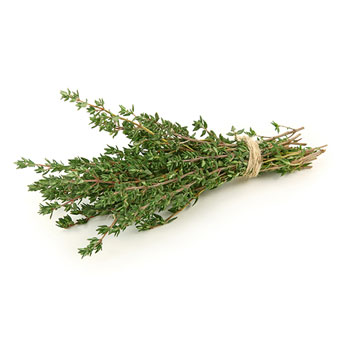Mohamed SH, Mohamed MSM, Khalil MS, Azmy M, Mabrouk MI Journal of Applied Microbiology, 2018 ABSTRACT: AIM: This study aimed to test biofilm inhibition activities of each of essential oils (EOs), main compounds of EOs and enzymes against pathogenic Klebsiella pneumonia. METHODS AND RESULTS: Effect of seven EOs and three enzymes was tested on formation… Read more »

- Botanical Name: Thymus vulgaris
- Alternative Names: Common Thyme
- Botanical Family: Lamiaceae
- Primary Constituent: Thymol
- Other Main Constituents: Para-cymene, Gamma-terpinene, Carvacrol
- Distillation Method: Steam Distillation
- Plant Part: Leaf
Chemical Composition of Essential Oils from Thymus vulgaris, Cymbopogon citratus, and Rosmarinus officinalis, and Their Effects on the HIV-1 Tat Protein Function
Feriotto G, Marchetti N, Costa V, Beninati S, Tagliati F, Mischiati C Chemistry & Biodiversity, 2018 ABSTRACT: New drugs would be beneficial to fight resistant HIV strains, in particular those capable of interfering with essential viral functions other than those targeted by highly active antiretroviral therapy drugs. Despite the central role played by Tat protein… Read more »
Toxicities of Selected Essential Oils, Silicone Oils, and Paraffin Oil against the Common Bed Bug (Hemiptera: Cimicidae)
Zha C, Wang C, Li A Journal of Economic Entomology ABSTRACT: The common bed bug [Cimex lectularius L. (Hemiptera: Cimicidae)] and tropical bed bug [Cimex hemipterus F. (Hemiptera: Cimicidae)] resurged in the United States and many other countries over the past decades. The need for safe and effective bed bug control products propelled the development… Read more »
Essential oils of culinary herbs and spices display agonist and antagonist activities at human aryl hydrocarbon receptor AhR
Bartoňková I, Dvořák Z Food Chemistry & Toxicology ABSTRACT: Essential oils (EOs) of culinary herbs and spices are used to flavor, color and preserve foods and drinks. Dietary intake of EOs is significant, deserving an attention of toxicologists. We examined the effects of 31 EOs of culinary herbs and spices on the transcriptional activity of human… Read more »
Antifungal and Anti-Biofilm Activity of Essential Oil Active Components against Cryptococcus neoformans and Cryptococcus laurentii
Kumari P, Mishra R, Arora N, Chatrath A, Gangwar R, Roy P, Prasad R Frontiers in Microbiology, 2017 ABSTRACT: Cryptococcosis is an emerging and recalcitrant systemic infection occurring in immunocompromised patients. This invasive fungal infection is difficult to treat due to the ability of Cryptococcus neoformans and Cryptococcus laurentii to form biofilms resistant to standard antifungal treatment…. Read more »
Antimicrobial activities of gaseous essential oils against Listeria monocytogenes on a laboratory medium and radish sprouts
Lee G, Kim Y, Kim H, Beuchat LR, Ryu JH International Journal of Food Microbiology, 2017 ABSTRACT: The aim of this study was to evaluate the antimicrobial activities of gaseous essential oils (EO gases) against Listeria monocytogenes on the surfaces of a laboratory medium and radish sprouts. We determined the minimal inhibitory concentration (MIC) and minimal lethal… Read more »
Essential oils showing in vitro anti MRSA and synergistic activity with penicillin group of antibiotics
Uzair B, Niaz N, Bano A, Khan BA, Zafar N, Iqbal M, Tahira R, Fasim F Pakistan Journal of Phamracological Science, 2017 ABSTRACT: This study was planned in order to investigate effective essential oils to inhibit in-vitro growth of Methicillin resistant Staphylococcus aureus (MRSA). In this study using disc diffusion method anti MRSA activity of ten diverse essential… Read more »
Acaricidal Activity and Synergistic Effect of Thyme Oil Constituents against Carmine Spider Mite (Tetranychus Cinnabarinus (Boisduval))
Wu L, Huo X, Zhou X, Zhao D, He W, Liu S, Liu H, Feng T, Wang C Molecules, 2017 ABSTRACT: Studies examining the use of essential oils as replacements for synthetic insecticides require an understanding of the contribution of each constituent present, interactions among these components, and how they relate to overall toxicity. In the present… Read more »
Antifungal activity of essential oils on two Venturia inaequalis strains with different sensitivities to tebuconazole
Muchembled J, Deweer C, Sahmer K, Halama P Environmental Science and Pollution Research, 2017 ABSTRACT: The antifungal activity of seven essential oils (eucalyptus, clove, mint, oregano, savory, tea tree, and thyme) was studied on Venturia inaequalis, the fungus responsible for apple scab. The composition of the essential oils was checked by gas chromatography-mass spectrometry. Each essential oil had its main compound…. Read more »
Antifungal properties of essential oils for improvement of indoor air quality: a review
Whiley H, Gaskin S, Schroder T, Ross K Reviews on Environmental Health, 2017 ABSTRACT: Concerns regarding indoor air quality, particularly the presence of fungi and moulds, are increasing. The potential for essential oils to reduce, control or remove fungi, is gaining interest as they are seen as a “natural” alternative to synthetic chemical fungicides. This review examines published… Read more »
